| Columns Retired Columns & Blogs |
Burmester 011 preamplifier Measurements
Sidebar 3: Measurements
Looking first at the Burmester 011's phono input (assessed at the tape-monitor outputs, and set to RIAA), the input impedance was 886 ohms at 1kHz when set to 1k ohm, and it didn't invert signal polarity (with pin 2 of the XLR jack driven by the hot phase). The RIAA equalization was very accurate, with just 0.1dB of positive error apparent in the upper bass and 0.15dB of rolloff at 20kHz (fig.1). The ultrasonic bandwidth was sensibly curtailed, the –3dB point lying at 90kHz, though the low frequencies rolled off very slightly, the output at 20Hz lying at –0.5dB. Channel separation was superb, any crosstalk lying beneath the noise floor (not shown).
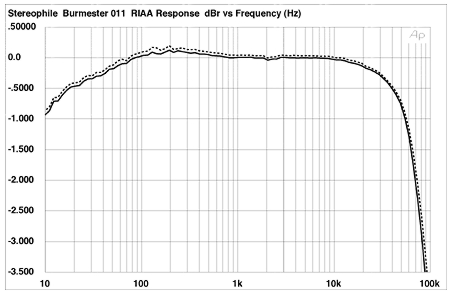
Fig.1 Burmester 011, phono input, RIAA error at 1mV input (0.5dB/vertical div., right channel dashed).
Even when set to low gain, the Burmester 011's phono stage offered 63.8dB of gain, which is high. The high-gain setting added 6dB to this figure. Despite these high voltage gains, the Burmester's phono-stage signal/noise ratios (low gain, ref. 500µV input at 1kHz) were excellent, at 65dB unweighted wideband, 68.8dB unweighted audioband, and 76dB A-weighted. Distortion levels were also very low, averaging 0.05%. However, while the phono stage's overload margin was very good at low and high frequencies, averaging 21.5dB ref. 500µV at 1kHz, it was just 6dB at 20kHz, an input level of 10mV suffering from 1% THD. This figure was taken with the low gain setting, suggesting that the Burmester's phono stage will be appropriate for use only with MC cartridges offering very low outputs.
The line stage offered a moderate input impedance of 11.5k ohms (balanced) and 7.7k ohms (unbalanced) at all frequencies. Absolute polarity was preserved for both balanced and unbalanced inputs and outputs (the XLR jacks appear to be wired with pin 2 hot), and the output impedance was a low 166 ohms (balanced) and 85 ohms (unbalanced) across the audioband. (Both figures include the series resistance of 6' of interconnect cable.)
With the line stage set to low gain, the maximum voltage gain with the volume control set to "60" was 12.1dB. Switching the preamp to its high-gain setting increased the maximum gain to 14.6dB. The volume control operated in 1dB steps, with the unity-gain setting therefore lying at "48" for the low-gain mode.
The Burmester's line stage offered excellent channel balance, its frequency response was flat within the audioband and wide in bandwidth (fig.2), and its ultrasonic rolloff, –3dB just above 200kHz, was not significantly affected by load or volume-control setting or by balanced/unbalanced operation. S/N ratios were superb, at 96.2dB A-weighted, balanced with the inputs shorted and the volume control at its maximum, ref. 1V output. The unweighted, wideband ratio was still excellent, at 82dB. Any crosstalk was buried in the noise floor below 8kHz or so, but rose to a still excellent 95dB (L–R) and 88dB (R–L) at 20kHz (not shown).
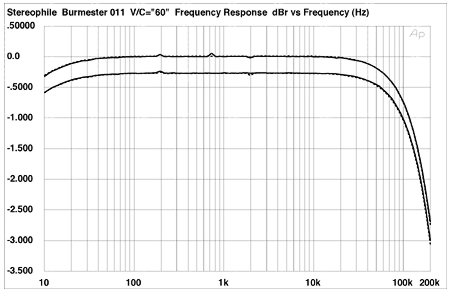
Fig.2 Burmester 011, line-stage balanced frequency response at 1V output into 100k ohms (top), 600 ohms (bottom). (0.5dB/vertical div., right channel dashed.)
The Burmester 011 was capable of very high output levels, balanced operation not clipping into 100k ohms until 22.5V RMS (fig.3). Even into 600 ohms, clipping still didn't occur until 15V, though distortion began to rise from its very low 100k levels above 2V RMS, which is about the maximum the preamp will be asked to deliver under real-world conditions. As expected, exactly half these voltage swings were available from the unbalanced output jacks.
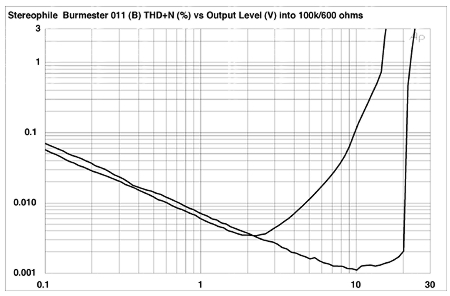
Fig.3 Burmester 011, Low setting, distortion (%)vs 1kHz balanced output voltage into (from bottom to top at 10V): 100k ohms, 600 ohms.
The very low levels of distortion into high impedances seen in fig.3 were achieved in the midrange. Though there were rises at low and high frequencies into 100k ohms, these were still to lower levels than seen at half the voltage swing into 600 ohms (fig.4). The distortion spectrum in the midrange showed a linear increase in harmonic energy with increasing order (fig.5), though all the harmonics lie well below –100dB (0.001%), and no harmonics above the fourth can be seen. The overall THD level in this graph (true sum of the harmonics) was just 0.0007%. At low frequencies (not shown), the second harmonic rose slightly. Intermodulation distortion was also low (fig.6).
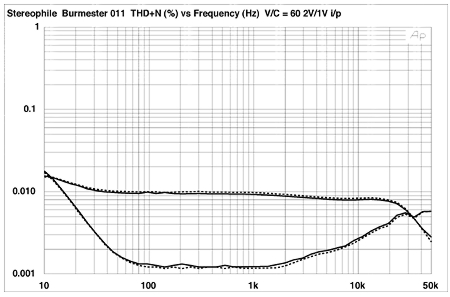
Fig.4 Burmester 011, THD+N (%)vs frequency at 2V into 100k ohms (bottom) and 1V into 600 ohms (top). (Right channel dashed.)
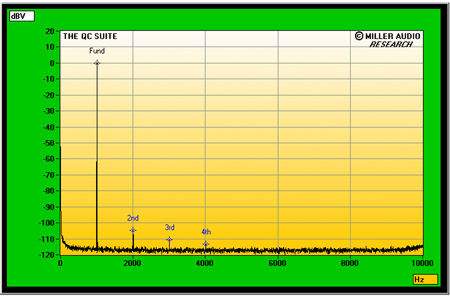
Fig.5 Burmester 011, spectrum of 1kHz sinewave, DC–10kHz, at 1V into 8k ohms (linear frequency scale).

Fig.6 Burmester 011, HF intermodulation spectrum, DC–24kHz, 19+20kHz at 1V into 8k ohms (linear frequency scale).
Although the limited HF overload margin of its phono stage, associated with its high gain, will preclude its use with high- or even moderate-output MC cartridges—BD's Lyra Titan, with a rated 1kHz output of 0.5mV at 5cm/s recorded velocity, is about the limit I would recommend—the Burmester 011's overall measured performance is superb, with very low levels of distortion and noise and a very high dynamic range.—John Atkinson
- Log in or register to post comments




































